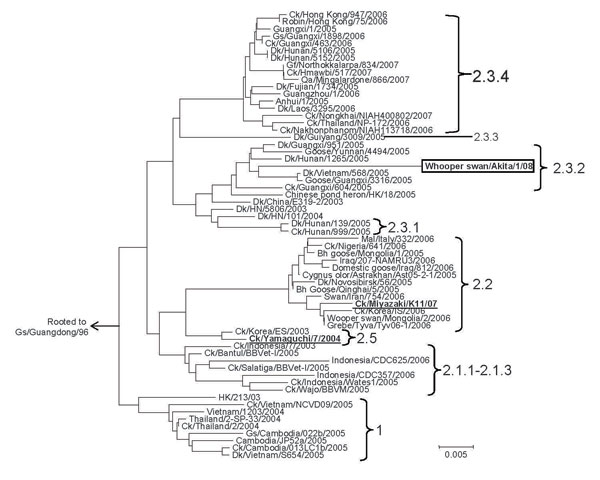Volume 14, Number 9—September 2008
Dispatch
Highly Pathogenic Avian Influenza Virus (H5N1) Isolated from Whooper Swans, Japan
Figure 2

Figure 2. Phylogenetic tree constructed based on the hemagglutinin (HA) 1 region (966 bp) of the HA gene of the highly pathogenic avian influenza viruses (H5N1). Clade designation follows the criteria proposed by the World Health Organization/World Organisation for Animal Health/Food and Agriculture Organization H5N1 Evolution Working Group (8). Representative strains of the previous highly pathogenic avian influenza outbreaks in Japan are in boldface. Scale bar represents number of nucleotide substitution per site.
References
- Ellis TM, Bousfield RB, Bissett LA, Dyrting KC, Luk GS, Tsim ST, Investigation of outbreaks of highly pathogenic H5N1 avian influenza in waterfowl and wild birds in Hong Kong in late 2002. Avian Pathol. 2004;33:492–505. DOIPubMedGoogle Scholar
- Chen H, Smith GJ, Zhang SY, Qin K, Wang J, Li KS, Avian flu: H5N1 virus outbreak in migratory waterfowl. Nature. 2005;436:191–2. DOIPubMedGoogle Scholar
- Liu J, Xiao H, Lei F, Zhu Q, Qin K, Zhang XW, Highly pathogenic H5N1 influenza virus infection in migratory birds. Science. 2005;309:1206. DOIPubMedGoogle Scholar
- Weber S, Harder T, Starick E, Beer M, Werner O, Hoffmann B, Molecular analysis of highly pathogenic avian influenza virus of subtype H5N1 isolated from wild birds and mammals in northern Germany. J Gen Virol. 2007;88:554–8. DOIPubMedGoogle Scholar
- Ducatez MF, Olinger CM, Owoade AA, Tarnagda Z, Tahita MC, Sow A, Molecular and antigenic evolution and geographical spread of H5N1 highly pathogenic avian influenza viruses in western Africa. J Gen Virol. 2007;88:2297–306. DOIPubMedGoogle Scholar
- Chen H, Li Y, Li Z, Shi J, Shinya K, Deng G, Properties and dissemination of H5N1 viruses isolated during an influenza outbreak in migratory waterfowl in western China. J Virol. 2006;80:5976–83. DOIPubMedGoogle Scholar
- Teifke JP, Klopfleisch R, Globig A, Starick E, Hoffmann B, Wolf PU, Pathology of natural infections by H5N1 highly pathogenic avian influenza virus in mute (Cygnus olor) and whooper (Cygnus cygnus) swans. Vet Pathol. 2007;44:137–43. DOIPubMedGoogle Scholar
- World Health Organization. 2007. Epidemic and Pandemic Alert and Response (EPR): Towards a unified nomenclature system for the highly pathogenic H5N1 avian influenza viruses [cited 2008 May 2] Available from http://www.who.int/csr/disease/influenza/nomen.ppt
- World Health Organization. Antigenic and genetic characteristics of (H5N1) viruses and candidate (H5N1) vaccine viruses developed for potential use as human vaccines [cited 2008 May 2]. Available from http://www.who.int/csr/disease/avian_influenza/guidelines/H5VaccineVirusUpdate20080214.pdf
- Ministry of the Environment, Government of Japan. Press release: preliminary results of 39th national survey of wild ducks and geese [in Japanese]. 2008 Apr 30 [cited 2008 May 2]. Available from http://www.env.go.jp/press/press.php?serial=9649
- Natural Parks Foundation. Seasons of Lake Towada. [in Japanese]. Updated 2008 Apr 25 [cited 2008 May 2]. Available from http://www.bes.or.jp/park/towada/now/towada_koyomi.htm
- Kanai Y, Sato F, Ueta M, Minton J, Higuchi H, Soma M, The migration routes and important rest sites of whooper swans satellite-tracked from northern Japan. Strix. 1997;15:1–3.
- Yamashina Institute for Ornithology. Atlas of Japanese migratory birds from 1961 to 1995. Yamashina (Japan): Bird Migration Research Center; 2002.
- Sturm-Ramirez KM, Hulse-Post DJ, Govorkova EA, Humberd J, Seiler P, Puthavathana P, Are ducks contributing to the endemicity of highly pathogenic H5N1 influenza virus in Asia? J Virol. 2005;79:11269–79. DOIPubMedGoogle Scholar
Page created: July 13, 2010
Page updated: July 13, 2010
Page reviewed: July 13, 2010
The conclusions, findings, and opinions expressed by authors contributing to this journal do not necessarily reflect the official position of the U.S. Department of Health and Human Services, the Public Health Service, the Centers for Disease Control and Prevention, or the authors' affiliated institutions. Use of trade names is for identification only and does not imply endorsement by any of the groups named above.